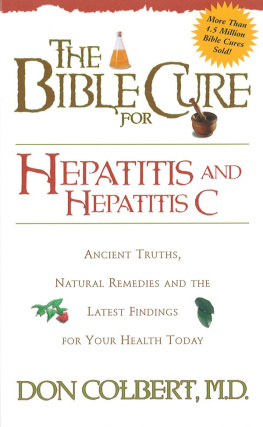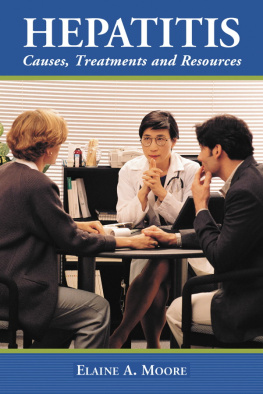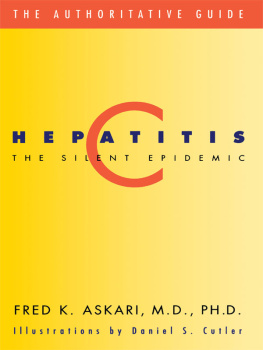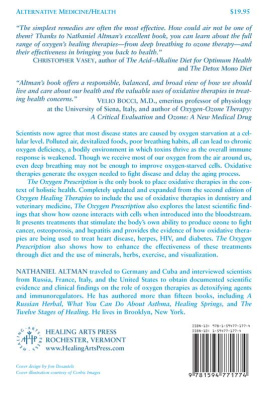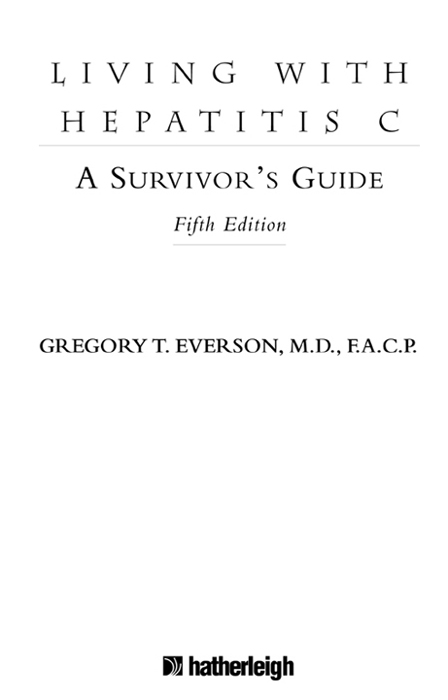DEDICATION
The first edition of Living with Hepatitis C: A Survivors Guide was published in 1998. Now, over 10 years later, we are still at it, trying to refine, improve and keep our book current with the rapidly evolving medical knowledge and treatments for hepatitis C. Maintaining quality and accuracy have been our goalsto do so takes time, a lot of time! And, most importantly patient loved ones. I wish to thank my family for tolerating my late hours of work, absence from home, and long periods at the computer. Special appreciation and thanks go to my wife, Linda, and sons, Brad and Todd. You truly are my inspiration. To all my friends and colleagues, I hope you get a chance to read this work and let me know if it is worthy of your readership.
Gregory T. Everson, M.D., F.A.C.P.
To my husband, Michael, my love, a truly good person who stands up for whats right, yet keeps a sense of humor, warmth, and openness. Your support, encouragement, and belief in this book made its creation possible. And to our children Ben and Yael, Shira and David, and Adam, who offered help and cheered me onIm proud of you, your values, and your strong sense of family.
Hedy Weinberg
We also thank our editor, Heather Ogilvie, for her guidance and valuable suggestions in the preparation of previous editions of Living with Hepatitis C, and our editor for this edition, June Eding.
In memory of Fred Kern, Jr., M.D., the authors and the publisher will contribute a portion of the profits from this book to the Kern Research Foundation for the Understanding and Treatment of Gastrointestinal and Liver Diseases to further hepatitis C research.
Kern Foundation
7500 East Dartmouth Avenue, No. 30
Denver, Colorado 80231-4264
Telephone (303) 750-5509
Fax (303) 750-4688
The authors would like to thank all those who have contributed to the Kern Foundation to further our research into hepatitis C and liver disease. We especially wish to acknowledge our publisher, Hatherleigh Press, for matching our own contributions of a portion of the profits from Living with Hepatitis C:A Survivors Guide and My Mom Has Hepatitis C.
These contributions, supplemented by the Liver Disease Fund at the University of Colorado Medical School, have underwritten the cost of a fully automated high-pressure liquid chromatograph (HPLC). This chromatograph analyzes compounds in blood and saliva that are used to measure liver function. The research goal is to develop tests that more accurately measure liver function and predict a patients clinical course of disease. These tests are currently being used in HALT C, the NIHsponsored trial of maintenance interferon to prevent disease progression in patients with chronic hepatitis C.
CONTENTS
BY J OHN M. V IERLING , M.D., C HAIR ,
Board of Directors, American Liver Foundation
1. W HAT I S H EPATITIS C?
An Introduction
2. W HEN YOU H AVE H EPATITIS C
Understanding the Diagnosis: Blood Tests and Biopsies
3. W HY M E ? W HAT A BOUT T HEM ?
How You Got Infected and How to Avoid Infecting Others
4. L EARNING A BOUT Y OUR L IVER : Y OUR B ODYS C HEMICAL F ACTORY
Liver Facts and Liver Disease Symptoms
5. T AKING C ARE OF Y OURSELF N UTRITIONALLY
Guidelines for Healthy Nutrition in Liver Disease
6. T AKING C ARE OF Y OURSELF E MOTIONALLY
Emotional Challenges of Chronic Illness
7. T AKING C ARE OF Y OURSELF F INANCIALLY
An Overview
8. E VOLUTION OF T REATMENT FOR H EPATITIS C
Improvements in Therapy from 1989 to 2006: The Interferon, Ribavirin, and Peginterferon Story
9. P EGYLATED I NTERFERONS P LUS R IBAVIRIN
The Current Standard-of-Care
10. L IVER T RANSPLANTS
A Miracle of Modern Medicine
11. L IVER C ANCER
Are You at Risk?
12. C O -I NFECTION WITH HIV/AIDS OR H EPATITIS B
Triple Trouble
13. C HILDREN WITH H EPATITIS C
A Growing Problem
14. R ESEARCH T RENDS
Hope for the Future
15.
PREFACE
L IVING WITH H EPATITIS C: A Survivors Guide grew out of a need I saw at the University of Colorado Health Sciences Center. When the first test for the virus became available around 1990, newly diagnosed patients asked questions but, unfortunately, we physicians had relatively few answers. As the years went by, our knowledge grew, and so did the task of educating the rapidly growing number of people diagnosed with hepatitis C.
To meet the publics need for information about hepatitis C, I began to give lectures specifically targeted to patients and their families. After one lecture, Hedy Weinberg, a hepatitis C patient and writer, approached me and suggested that we turn the lecture series into a guidebook for our patients at the clinic. What began as a simple pamphlet quickly turned into a long-term project that resulted in the publication of the first version of this book in 1997.
As we wrote and rewrote the text, we tried to create a useful guide that would take the patient step-by-step through the process of diagnosis and ongoing care. We tried to anticipate questions, translate medical jargon, and reduce the fear of the unknown. Therefore, we also presented overviews of emotional, financial, and nutritional issues that accompany this chronic illness. In subsequent editions, we added new chapters dealing with liver cancer, co-infection, and children. In these pages you will hear the voices of patients and staff at the University Hospital and the University of Colorado Health Sciences Center who generously contributed their knowledge and experiences and encouraged us to complete the work.
Our third edition (2001) continued to update information and resources while trying to maintain our goal of presenting complex medical terms in language that patients can understand. And, in our fourth edition a new standard of care, the combination of pegylated interferon with ribavirin had emerged (Emerging Standard-of-Care). We also enlarged the scope of the co-infection chapter to include hepatitis B, as well as HIV/AIDS.
As we prepare each new edition, we note the advances in our knowledge and treatment of hepatitis C. This, our Fifth Edition of Living with Hepatitis C:A Survivors Guide has added a 15th Chapter to the sagathe new and emerging advances in treating hepatitis Cprotease inhibitors, polymerase inhibitors, immune modulators, maintenance therapy, and other key issues. We still have a long way to go to eradicate the virus, but the future looks hopeful.
We continually update this guidebook to help people cope with a disease that affects over four million Americans. In a short clinical visit, people often keep a stiff upper lip. But for this book, patients shared their experiencesthe funny and hopeful times, as well as the frightening, sad moments. I gained a new appreciation and insight into my patients lives.
Throughout the book we emphasize the need for thoughtful well-controlled clinical and basic research of hepatitis C.
One last word: Although Living with Hepatitis C:A Survivors Guide is a detailed reference guide, it does not replace the advice and care of your physician, nor does it give legal advice. Instead, it is designed solely to educate patients and their families about hepatitis C and how it affects their lives. Consult appropriate specialists and always work closely with your doctor when making medical decisions.



